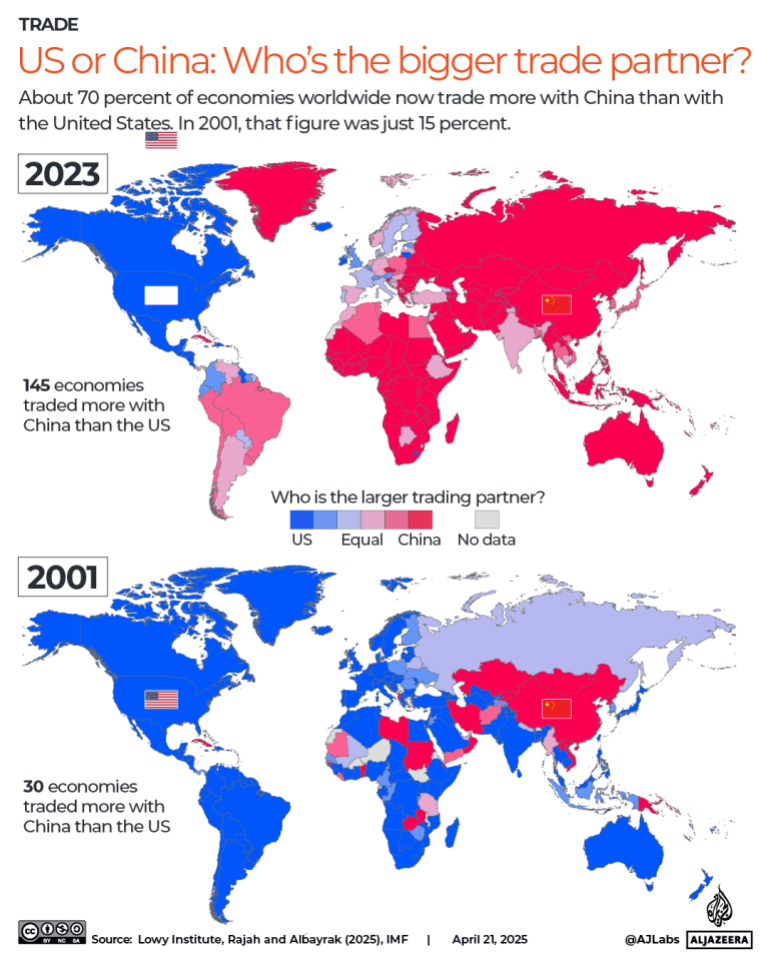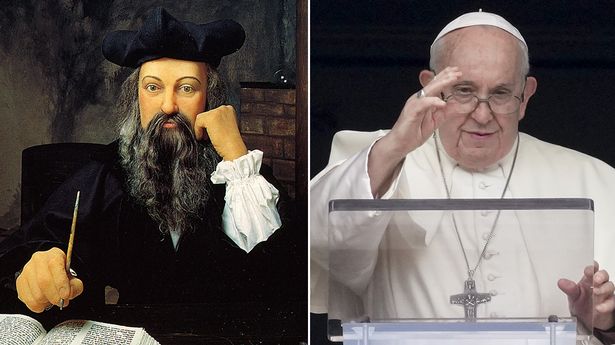China has warned countries against striking trade deals with the United States at Beijing’s expense, ratcheting up its rhetoric in a spiralling trade war between the world’s two biggest economies.
Responding to reports suggesting that US President Donald Trump’s administration is pressuring other countries to isolate China, a spokesperson for China’s Ministry of Commerce said on Monday that Beijing “will take countermeasures in a resolute and reciprocal manner” against nations that align with the US against it.
The warning comes as countries prepare for talks with the US to seek exemptions from “reciprocal” tariffs that Trump imposed and then later paused on about 60 trading partners.
So what’s this latest verbal spat about, how much clout does China wield in global trade and can Trump drive a wedge between other capitals and Beijing?
What’s the backdrop?
The Wall Street Journal recently reported that Trump was seeking to use tariff talks to push US economic partners to curb trade with China and rein in Beijing’s manufacturing dominance.
In return, these nations could secure reductions in US levies and trade barriers. The Trump administration has said it is in negotiations with more than 70 countries.
On Monday, China’s Commerce Ministry hit back, warned other nations that “to seek one’s own temporary selfish interests at the expense of others’ interests is to seek the skin of a tiger”. In effect, it argued that those trying to strike deals with the US – the tiger – would be eaten up themselves eventually.
The ministry also said China would in turn target all countries that fell in line with US pressure to hurt Beijing.
What’s the status of US-China trade?
After Trump suspended his “reciprocal tariffs” on major US trading partners on April 9, he ramped them up on China. US trade levies on most Chinese exports have climbed to 145 percent. Beijing has retaliated with duties of its own at 125 percent on US goods.
Trump has long accused China of exploiting the US on trade, casting his tariffs as necessary to revive domestic manufacturing and return jobs to the US. He also wants to use tariffs to finance future tax cuts.
For his part, Chinese President Xi Jinping travelled to three Southeast Asian countries last week to bolster regional ties. He called on trading partners, including Vietnam, to oppose unilateral bullying.
“There are no winners in trade wars and tariff wars,” Xi said in an article published in Vietnamese media, without mentioning the US.
As with other countries in Southeast Asia, Vietnam has been caught in the trade war’s crossfire. It is not only a manufacturing hub itself, but China also frequently uses it to dispatch exports to the US to avoid the tariffs imposed by the first Trump administration on Beijing in 2018.
Elsewhere, the Trump administration has begun talks with East Asian allies over the tariffs with a Japanese delegation visiting Washington, DC, last week and South Korean officials set to arrive this week.
Many countries now find themselves stuck between the world’s two biggest economies – China, a large source of manufactured goods and a key trading partner, and the US, a crucial export market.
How dependent is the world on Chinese exports?
In a report published in January by the Lowy Institute, a Sydney-based think tank, analysts found that in 2023, about 70 percent of countries imported more from China than they did from the US.
China’s rapid ascent as a trading superpower can be traced back to 2001, the year it joined the World Trade Organization (WTO) and when it started to dominate global manufacturing after years of successful protectionist industrial policies.
During the 2000s, China benefitted from the relocation of international supply chains, turbocharged by substantial inflows of foreign investment, large pools of low-cost labour and an undervalued currency exchange rate.
By 2023, China had become the largest trading partner for at least 60 countries, almost twice as many as for the US, which remained the largest trading partner for 33 economies.
The gap between them is also widening in many countries: The Lowy Institute analysis found that in 2023, 112 economies traded more than twice as much with China as they did with the US, up from 92 in 2018 during Trump’s first trade war.
“The critical dependence China has developed around the world, especially in Asia, means that lots [of trading partners] cannot do without China,” said Alicia Garcia-Herrero, an economist at the investment bank Natixis. “From critical minerals to silicon chips, Chinese exports are almost irreplaceable. ”
Has world trade tipped more in China’s favour since Trump’s last trade war?
In 2018, two years into his first administration, Trump imposed 15 percent tariffs on more than $125bn in Chinese goods, including footwear, smartwatches and flat-screen TVs.
Since then, the US has become an even more important source of demand for non-Chinese exports, especially from Mexico and Vietnam, reflecting the impact of years of US tariffs on China.
Yet if Trump’s aim in part was to hurt Beijing, his first salvoes failed.
Since 2018, many more nations have deepened their trade relations with China – at the expense of the US.
When China joined the WTO, more than 80 percent of countries had more two-way trade with the US than with China. That had fallen to just 30 percent by 2018, the year of Trump’s first tariffs on China, according to the Lowy Institute analysis.
That trend has only solidified since then: In 2018, 139 nations traded more with China than with the US. By 2023, that number had risen to 145, and about 70 percent of the world’s economies now trade more with China than with the US – up from just 15 percent in 2001.
“Trump doesn’t seem to understand how important Chinese trade flows have become,” Garcia-Herrero told Al Jazeera. “What’s more, he’s not offering much by way of carrots, like more investment, so I don’t think he’ll get what he wants. ”
Can countries afford to alienate China on trade?
According to Garcia-Herrero, a few countries such as Mexico that have particularly deep trade links with the US, probably will “say no to Chinese imports”.
However, she highlighted that “China’s presence in supply chains is so massive for most of America’s other trade partners, decoupling is virtually impossible. ”
Indeed, around the world, China has become an invaluable source of imports. The European Union, for instance, had a trade deficit with China worth 396 billion euros ($432bn) in 2022, up from 145 billion euros ($165bn) in 2016.
China accounts for 20 percent of EU goods imports. The equivalent figure in Great Britain is 10 percent. Last week, Treasury Secretary Rachel Reeves said it would be “very foolish” for the UK to engage in less trade with China.
Across the developing world, China’s trade role is just as crucial. Roughly a quarter of Bangladesh’s and Cambodia’s total imports are from China. Nearly a fifth of Nigeria’s and Saudi Arabia’s goods imports come from China.
“Trump’s trade policy is shortsighted,” Garcia-Herrero said. “Trying to pry trade away with China may work in countries where the US has military bases. … They may have to accept the US’s concerns. ”















